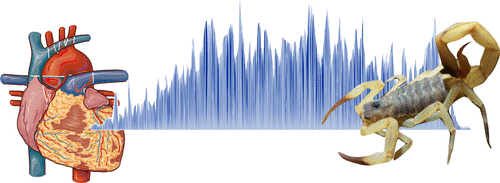当前位置:
X-MOL 学术
›
J. Proteome Res.
›
论文详情
Our official English website, www.x-mol.net, welcomes your feedback! (Note: you will need to create a separate account there.)
Moving Pieces in a Cellular Puzzle: A Cryptic Peptide from the Scorpion Toxin Ts14 Activates AKT and ERK Signaling and Decreases Cardiac Myocyte Contractility via Dephosphorylation of Phospholamban.
Journal of Proteome Research ( IF 4.4 ) Pub Date : 2020-06-29 , DOI: 10.1021/acs.jproteome.0c00290 Diana P Goméz-Mendoza 1 , Rafael Pereira Lemos 1 , Itamar C G Jesus 1 , Vladimir Gorshkov 2 , Shaun M K McKinnie 3 , John C Vederas 3 , Frank Kjeldsen 2 , Silvia Guatimosim 1 , Robson Augusto Santos 1 , Adriano M C Pimenta 4 , Thiago Verano-Braga 1
Journal of Proteome Research ( IF 4.4 ) Pub Date : 2020-06-29 , DOI: 10.1021/acs.jproteome.0c00290 Diana P Goméz-Mendoza 1 , Rafael Pereira Lemos 1 , Itamar C G Jesus 1 , Vladimir Gorshkov 2 , Shaun M K McKinnie 3 , John C Vederas 3 , Frank Kjeldsen 2 , Silvia Guatimosim 1 , Robson Augusto Santos 1 , Adriano M C Pimenta 4 , Thiago Verano-Braga 1
Affiliation

|
Cryptic peptides (cryptides) are biologically active peptides formed after proteolysis of native precursors present in animal venoms, for example. Proteolysis is an overlooked post-translational modification that increases venom complexity. The tripeptide KPP (Lys-Pro-Pro) is a peptide encrypted in the C-terminus of Ts14—a 25-mer peptide from the venom of the Tityus serrulatus scorpion that has a positive impact on the cardiovascular system, inducing vasodilation and reducing arterial blood pressure of hypertensive rats among other beneficial effects. A previous study reported that KPP and its native peptide Ts14 act via activation of the bradykinin receptor B2 (B2R). However, the cellular events underlying the activation of B2R by KPP are unknown. To study the cell signaling triggered by the Ts14 cryptide KPP, we incubated cardiac myocytes isolated from C57BL/6 mice with KPP (10–7 mol·L–1) for 0, 5, or 30 min and explored the proteome and phosphoproteome. Our results showed that KPP regulated cardiomyocyte proteins associated with, but not limited to, apoptosis, muscle contraction, protein turnover, and the respiratory chain. We also reported that KPP led to AKT phosphorylation, activating AKT and its downstream target nitric oxide synthase. We also observed that KPP led to dephosphorylation of phospholamban (PLN) at its activation sites (S16 and T17), leading to reduced contractility of treated cardiomyocytes. Some cellular targets reported here for KPP (e.g., AKT, PLN, and ERK) have already been reported to protect the cardiac tissue from hypoxia-induced injury. Hence, this study suggests potential beneficial effects of this scorpion cryptide that needs to be further investigated, for example, as a drug lead for cardiac infarction.
中文翻译:

在细胞难题中移动碎片:来自蝎毒素Ts14的隐肽激活AKT和ERK信号,并通过磷酸磷脂的去磷酸化作用降低心肌细胞的收缩力。
隐性肽(隐性肽)是例如在动物毒液中存在的天然前体经蛋白水解后形成的生物活性肽。蛋白质水解是一种被忽视的翻译后修饰,会增加毒液的复杂性。三肽KPP(Lys-Pro-Pro)是在Ts14的C端加密的肽-Tsus serrulatus毒液的25-mer肽蝎子对心血管系统有积极影响,可诱导血管扩张并降低高血压大鼠的动脉血压,并具有其他有益作用。先前的一项研究报道,KPP及其天然肽Ts14通过激活缓激肽受体B2(B2R)起作用。但是,由KPP激活B2R的细胞事件尚不清楚。研究细胞由TS14 cryptide KPP信令触发,我们从孵育C57BL / 6小鼠分离KPP(10心肌细胞-7莫尔-1)停留0、5或30分钟,并探索了蛋白质组和磷酸化蛋白质组。我们的结果表明,KPP调节与但不限于凋亡,肌肉收缩,蛋白质更新和呼吸链相关的心肌细胞蛋白质。我们还报道了KPP导致AKT磷酸化,激活AKT及其下游目标一氧化氮合酶。我们还观察到,KPP导致磷酸lamban(PLN)在其激活位点(S16和T17)发生去磷酸化,从而导致处理过的心肌细胞的收缩力降低。已经报道了此处报道的一些针对KPP的细胞靶标(例如AKT,PLN和ERK)可以保护心脏组织免受缺氧引起的损伤。因此,这项研究表明,需要进一步研究这种蝎子的秘密作用,例如,
更新日期:2020-08-08
中文翻译:

在细胞难题中移动碎片:来自蝎毒素Ts14的隐肽激活AKT和ERK信号,并通过磷酸磷脂的去磷酸化作用降低心肌细胞的收缩力。
隐性肽(隐性肽)是例如在动物毒液中存在的天然前体经蛋白水解后形成的生物活性肽。蛋白质水解是一种被忽视的翻译后修饰,会增加毒液的复杂性。三肽KPP(Lys-Pro-Pro)是在Ts14的C端加密的肽-Tsus serrulatus毒液的25-mer肽蝎子对心血管系统有积极影响,可诱导血管扩张并降低高血压大鼠的动脉血压,并具有其他有益作用。先前的一项研究报道,KPP及其天然肽Ts14通过激活缓激肽受体B2(B2R)起作用。但是,由KPP激活B2R的细胞事件尚不清楚。研究细胞由TS14 cryptide KPP信令触发,我们从孵育C57BL / 6小鼠分离KPP(10心肌细胞-7莫尔-1)停留0、5或30分钟,并探索了蛋白质组和磷酸化蛋白质组。我们的结果表明,KPP调节与但不限于凋亡,肌肉收缩,蛋白质更新和呼吸链相关的心肌细胞蛋白质。我们还报道了KPP导致AKT磷酸化,激活AKT及其下游目标一氧化氮合酶。我们还观察到,KPP导致磷酸lamban(PLN)在其激活位点(S16和T17)发生去磷酸化,从而导致处理过的心肌细胞的收缩力降低。已经报道了此处报道的一些针对KPP的细胞靶标(例如AKT,PLN和ERK)可以保护心脏组织免受缺氧引起的损伤。因此,这项研究表明,需要进一步研究这种蝎子的秘密作用,例如,

























 京公网安备 11010802027423号
京公网安备 11010802027423号